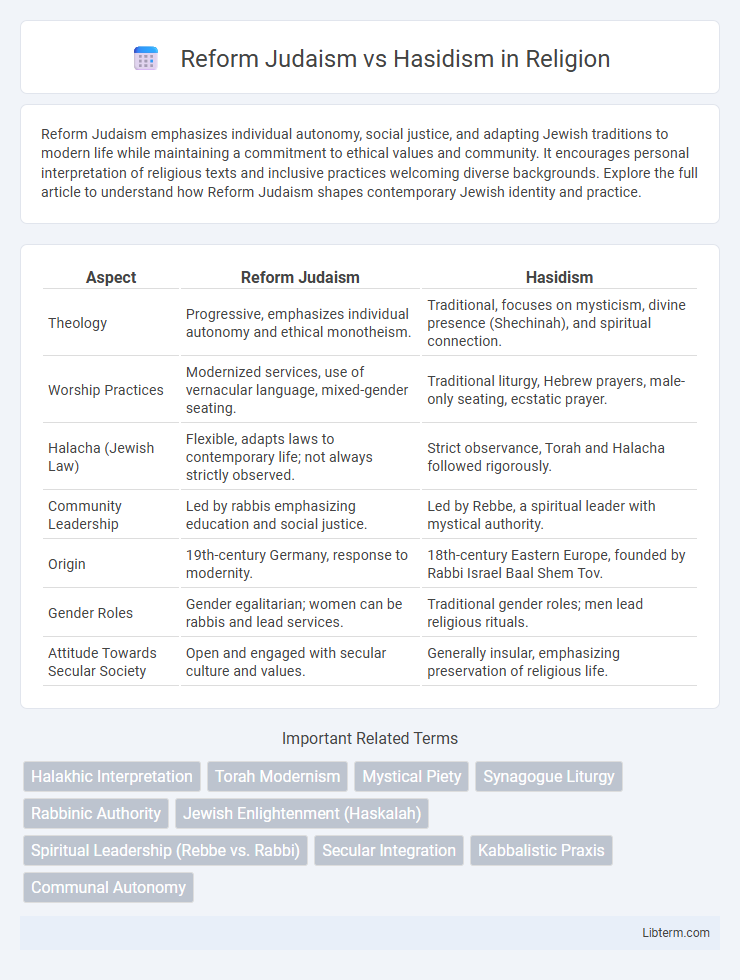Reform Judaism emphasizes individual autonomy, social justice, and adapting Jewish traditions to modern life while maintaining a commitment to ethical values and community. It encourages personal interpretation of religious texts and inclusive practices welcoming diverse backgrounds. Explore the full article to understand how Reform Judaism shapes contemporary Jewish identity and practice.
Table of Comparison
| Aspect | Reform Judaism | Hasidism |
|---|---|---|
| Theology | Progressive, emphasizes individual autonomy and ethical monotheism. | Traditional, focuses on mysticism, divine presence (Shechinah), and spiritual connection. |
| Worship Practices | Modernized services, use of vernacular language, mixed-gender seating. | Traditional liturgy, Hebrew prayers, male-only seating, ecstatic prayer. |
| Halacha (Jewish Law) | Flexible, adapts laws to contemporary life; not always strictly observed. | Strict observance, Torah and Halacha followed rigorously. |
| Community Leadership | Led by rabbis emphasizing education and social justice. | Led by Rebbe, a spiritual leader with mystical authority. |
| Origin | 19th-century Germany, response to modernity. | 18th-century Eastern Europe, founded by Rabbi Israel Baal Shem Tov. |
| Gender Roles | Gender egalitarian; women can be rabbis and lead services. | Traditional gender roles; men lead religious rituals. |
| Attitude Towards Secular Society | Open and engaged with secular culture and values. | Generally insular, emphasizing preservation of religious life. |
Origins and Historical Development
Reform Judaism originated in early 19th-century Germany as a response to Enlightenment ideas, emphasizing modernization and integration into secular society while adapting traditional Jewish laws and rituals. Hasidism began in the 18th century in Eastern Europe, founded by Rabbi Israel Baal Shem Tov, focusing on mysticism, spiritual joy, and a close relationship with a Rebbe. Reform Judaism evolved through synagogues promoting rationalism and ethical monotheism, whereas Hasidism maintained strong communal ties and preserved traditional practices with mystical experiences.
Core Beliefs and Philosophical Differences
Reform Judaism emphasizes individual autonomy, ethical monotheism, and adapting Jewish laws to modern life, often minimizing ritualistic observance and traditional Halacha. Hasidism centers on mysticism, spiritual experience, and strict adherence to Halachic codes, highlighting the role of a Tzaddik (righteous leader) for communal and personal guidance. The philosophical divergence lies in Reform's progressive reinterpretation of Judaism versus Hasidism's preservation of orthodox spirituality and communal unity through ritual and mysticism.
Approaches to Jewish Law (Halacha)
Reform Judaism adopts a flexible approach to Halacha, emphasizing personal autonomy and modern ethical values, often allowing individuals to interpret or modify traditional laws to fit contemporary life. Hasidism strictly adheres to Halacha, following traditional interpretations and rulings rooted in centuries-old rabbinic authority, with a strong focus on mysticism and communal religious practice. The divergence reflects Reform's adaptation to modernity versus Hasidism's commitment to preserving historical observance and spiritual intensity within Jewish law.
Worship Practices and Rituals
Reform Judaism emphasizes flexible worship practices, incorporating vernacular languages and gender-inclusive participation, often featuring shorter services with mixed musical styles. Hasidism adheres to traditional, mystical rituals with extended prayer sessions, use of Hebrew, and distinctive customs like the nigun (wordless melodies) to foster spiritual connection. Ritual observance in Hasidism remains strict, preserving halachic (Jewish law) standards, while Reform Judaism adapts practices to modern contexts.
Attitudes Toward Modernity and Secular Society
Reform Judaism embraces modernity and secular society by adapting religious practices and beliefs to contemporary values, emphasizing individual autonomy and inclusivity. Hasidism maintains a more traditional stance, prioritizing strict adherence to religious law and community customs while generally limiting engagement with secular culture. These differing attitudes shape their approaches to education, gender roles, and integration within broader society.
Community Structure and Leadership
Reform Judaism features a decentralized community structure emphasizing individual autonomy and egalitarian leadership, often led by rabbis who support progressive interpretations of Jewish law and inclusive worship practices. Hasidism maintains a tightly-knit community organized around a Rebbe, a spiritual leader believed to have mystical authority, who provides guidance in religious, social, and personal matters. The contrasting leadership models highlight Reform Judaism's adaptive, pluralistic approach versus Hasidism's hierarchical, tradition-centered governance.
Views on Gender Roles and Equality
Reform Judaism emphasizes gender equality by promoting equal participation of women and men in religious rituals, including the ordination of female rabbis and cantors. Hasidism, rooted in traditional Orthodox Judaism, maintains distinct gender roles with men and women adhering to separate religious obligations and often segregated worship spaces. While Reform communities actively advocate for LGBTQ+ inclusion, Hasidic groups typically uphold conservative stances aligned with traditional halachic interpretations.
Education and Religious Study
Reform Judaism emphasizes modern, critical approaches to Jewish education, encouraging inclusive study that integrates secular knowledge and promotes individual interpretation of religious texts. Hasidism prioritizes immersive, traditional study of Torah and mystical teachings within tight-knit communities, often guided by charismatic spiritual leaders known as Rebbes. Educational practices in Hasidism deeply intertwine with daily religious life, focusing on communal prayer, ethical conduct, and transmission of oral traditions.
Appearance and Dress Code
Reform Judaism generally embraces modern, casual attire reflecting individual choice and contemporary fashion trends, with less emphasis on traditional dress codes, allowing for a diverse range of clothing styles during services and daily life. Hasidism maintains strict adherence to traditional clothing, including black suits, white shirts, wide-brimmed hats for men, and modest attire for women, often reflecting historical Eastern European influences and serving as visible markers of religious identity. These distinct approaches to appearance underscore broader theological and cultural differences between the progressive values of Reform Judaism and the conservative, community-centered ethos of Hasidism.
Influence and Presence in Contemporary Judaism
Reform Judaism significantly shapes contemporary Jewish practice through its emphasis on individual autonomy, gender equality, and integration with modern secular society, representing the largest Jewish denomination in the United States. Hasidism maintains a strong presence primarily in ultra-Orthodox communities, particularly in neighborhoods like Brooklyn and Jerusalem, where it upholds strict adherence to traditional Jewish law and mystical spirituality. The contrast between Reform Judaism's progressive adaptation and Hasidism's preservation of tradition illustrates the diverse spectrum of beliefs and practices influencing modern Jewish identity globally.
Reform Judaism Infographic

 libterm.com
libterm.com